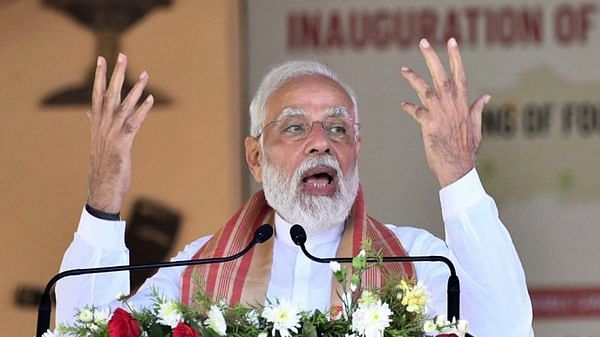As ardent believers, Indians like having a triumphant story attached to that belief. In 2014, a new belief emerged with Narendra Modi, and in that belief, many people in the country saw his story as their own, led by the promise of acche din.
I, too, liked the novelty and freshness of the Modi story. As such I was giddy, excited and charmed to have gotten the rare opportunity to accompany senior journalist Hari Shankar Vyas to interview the BJP-led National Democratic Alliance’s prime ministerial candidate in 2014.
By the time of the interview, Modi had become the preferred choice and was aware that many people saw him as their hope. The pressure was surmountable, but he seemed unperturbed. He knew his strengths, aware of the charm and sentiment that surrounded him. When he was asked by Vyas about his Idea of India, the plan for bringing ‘lost glory’, Modi explained each with astute clarity. His passion and determination for weaving the old customs with a modern India gave me goosebumps. Modi was making the job of the prime minister look so easy and fun.
Also read: Why the Modi government gets away with lies, and how the opposition could change that
Birth of a new story
On 16 May 2014, amid a lot of excitement and fanfare, with the 15th prime minister came a new story. Playing on his own humble beginnings, cashing on being the ‘outsider’ in Delhi politics, Modi ripped through the mood that was frothing with anger, the uncharted disillusionment with politics and politicians. Often used for vote bank politics, he dubbed and appealed to the sentiments of the larger Indian — the young, the backward, the rural and the middle class. He became their representative, their Goliath to the story.
In a world that has produced many storytellers — from Abraham Lincoln, Richard Nixon, Winston Churchill, Margaret Thatcher, Angela Merkel to Barack Obama — India only had one leader whose narratives were compelling and compassionate, one that allowed Indians to create a story for the nation too. He was the first Prime Minister of India, Jawaharlal Nehru (who is much scorned today).
At the time, though, India had a story in Nehru and in Nehru’s there was an India story, as such for the generation of Independence there was a Nehru’s India to thrive and jiggle on. But after him, there existed a vacuum of storytellers and stories. India grew but not its story. Modi’s predecessor was called a ‘Silent Prime Minister’, the ‘Accidental Prime Minister’, his work and the economic progress of his era disavowed and besmirched, all because Manmohan Singh was neither the story nor an adept storyteller. For a whole generation, particularly the millennials, there was no role model in politics, no story, no narrative, except politics equated to the dirty realm of power and corruption.
Then 2014 happened. The country leaped straight from the chugging engine of Nehru’s India onto the bullet train of Modi’s India. Today, the public draws comparisons between Modi and Nehru and the narrative, in the 75th year of Independence, is that there was once a Nehru to a Modi of today.
Also read: Modi faces no political costs for suffering he causes. He’s just like Iran’s Ali Khamenei
Storyteller is gone, story remains
Eight years have gone by. Modi has held the post of prime minister with elan, and the question everyone is trying to answer is: ‘kya achhe beete aath saal (were the eight years good?).’
There are floods of editorials brimming with applause and harsh criticism, scrutinising the eight years of Modi government. Economically, socially, culturally, the good and bad decisions, it’s a mix bag of hit and miss. After all, attaining perfection is a myth. As such I believe Modi’s time as Prime Minister should not just be marked and graded on the policies that are being used to shape and change India but till how far can his story be pushed into the conscience of the masses. Modi believes in staying connected directly with the people. That’s the equation that matters to him.
For 75-year-old Samta Prasad Chaudhary in Gorakhpur, Uttar Pradesh, the Indian students trapped in Ukraine following Russia’s invasion were brought back safely under the leadership of Modi. “Bharat ka jhanda jahan hota tha, wahan Russia nahin attack karta (wherever there would be the Indian flag, Russia would not attack),” he had said when I met him during the 2022 UP election. The rescue of the stranded students made Prasad forget his woes and anger against the Yogi Adityanath government over the rising cost and cows eating his crops.
Today, the BJP, either on its own or in alliance, is ruling in 17 states, covering 44 per cent of the country’s geographical area. Despite the mismanagement during the Covid pandemic and the large number of deaths, Modi’s approval ratings have surged globally to a high of 70 per cent, the highest rating accorded to any leader in the survey. Moreover, Modi has not allowed the economic stress, the rising division among communities, and China entering into India to overshadow his popularity.
Modi casts a long shadow, becoming the politician who has expanded the reach of his party but continues to satisfy the psychological needs of his devoted audience. In these eight years, while the idea of achhe din may have taken a back seat, the story, the plot and the cult of Modi endures. The writings on the wall say that people still have hope and confidence in Modi.
The story, therefore, is still roaring. He keeps adding new ideas to his ‘idea of India’ and his supporters latch onto it. But he is no longer the storyteller and he knows this. Today, the story of Modi’s legacy is in the hands of the 1.25 crore Indians who are still searching for achhe din.
Shruti Vyas is a journalist based in New Delhi. She writes on politics, international relations and current affairs. Views are personal.
(Edited by Prashant)



